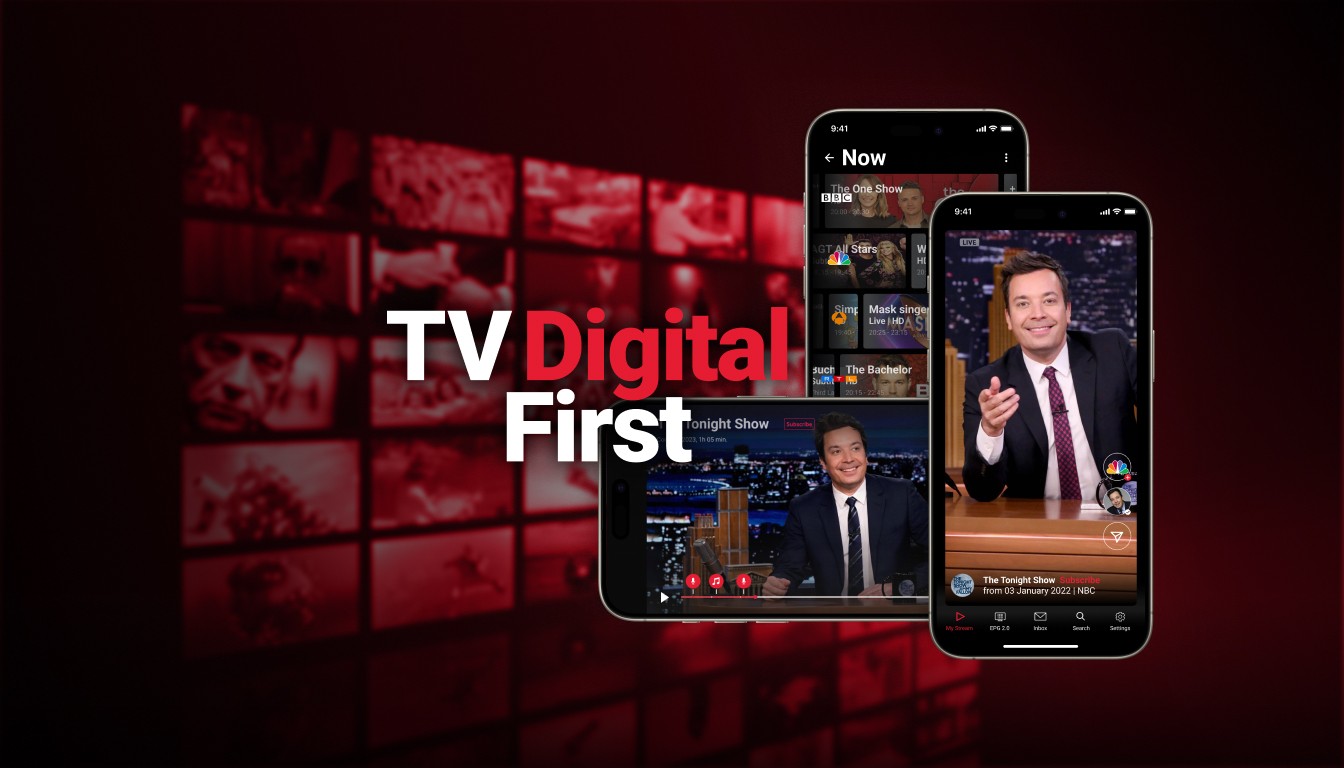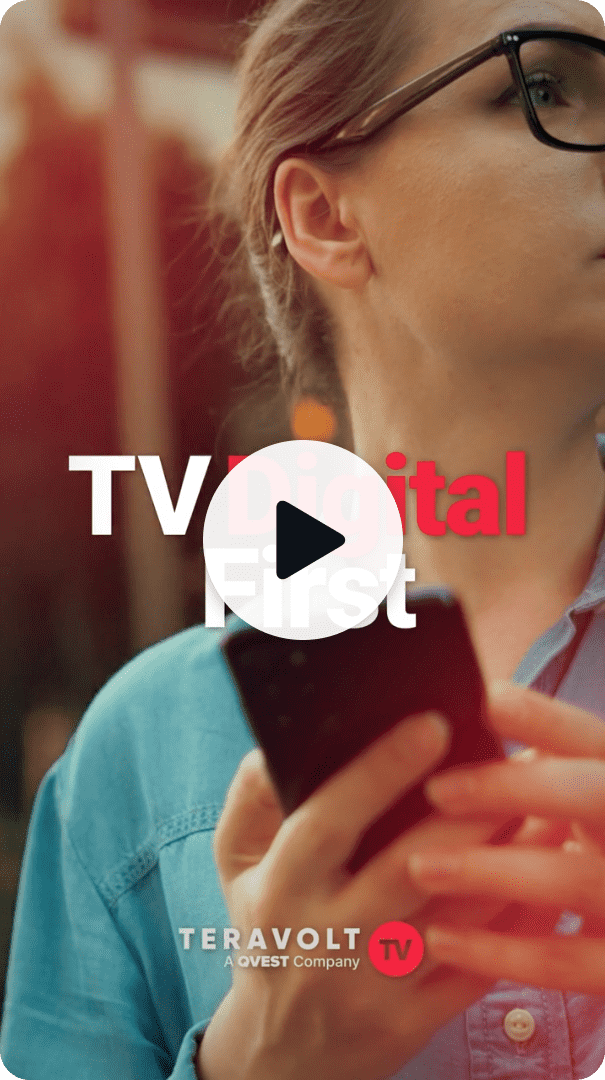Whether you notice it in your digital usage or see it in the statistics, the viewing time of audiovisual content continues to grow. A recent publication by the private media association VAUNET shows that the share of audio and audiovisual media use in Germany's total media time budget (age 14 and up) rose to almost 90 percent in 2022. Taken together, tablets and cell phones have overtaken TV in prime time. Moreover, the mixed-use of cell phones and TV screens is increasing in various everyday situations and even simultaneously.
Because of this, TV broadcasters should look at the available technologies and content potential to more closely accompany their viewers throughout the day while avoiding media breaks. After all, social media platforms use increasingly precise algorithms to retain their users, and they know why: the growth lies in mobile's continuous and ubiquitous offering. TeraVolt has developed a "TV Digital First" concept that meets these challenges and provides several solutions.
To win back viewing time, TV must offer mobile services
Up to now, TV stations have often digitally published elements of their formats on Instagram, TikTok, Twitter, or Facebook. In this way, they hope to attract more attention and, indirectly, more ratings and additional revenues from advertising sales via those platforms. However, the unpredictable algorithms that social media platforms employ to pass on this content remain a black box for TV broadcasters. Even personal user data flows solely into the value chain of the big tech companies. For TV broadcasters and platforms, retaining content sovereignty is essential for future success in target-group-specific marketing. Directly addressing a known user based on their customer profile is more interesting for any sponsor or advertiser than a general, non-customer-specific social media sweep. Independent user data is also more valuable and can be marketed better.
In-house development: TVXRAY for the community
TeraVolt solves this dilemma by programming applications for TV stations and broadcasters that contain additional content for users or subscribers. One example is the DFL Bundesliga Interactive Feed, a personalized service for soccer fans. The starting point is the TeraVolt development TVXRAY, an AI-based SaaS-enabled SDK solution that can be integrated into over-the-top clients. The guiding principle behind this intelligent technology is simple: users want to follow people, brands, and topics seamlessly within the same platform, staying on the same channel to view contributions, posts, and comments from the community.
TeraVolt calls it "the Gen Z upgrade for live sports broadcasting," but it's more than that. TVXRAY notifies viewers in the DFL Bundesliga Interactive Feed and provides them with game statistics they might be interested in. TVXRAY plays video alerts from matches taking place simultaneously. In addition, it delivers background information on players interactively. Whether on a cell phone or the web, the EPG on SmartTV or set-top boxes, statistics, and images can be retrieved with a "click" – all synchronized with the current broadcast. This enhances the viewers' understanding of the game and boosts their engagement with the streaming.
An excellent application that increases usage
Playful elements keep the fan on the ball within their medium. At the same time, the system learns about the user's preferences via the "Activity Feed" and optimizes their customer profile, whether for advertising or premium content.
Incidentally, the German Soccer League and TeraVolt received several awards for the Bundesliga Interactive Feed in 2021. In addition, the DFL achieved over 30 percent more usage with TVXRAY. Around 80 percent of viewers actively used the video features, selecting individual highlights for themselves while remaining in the original stream. Broadcast partners in Japan, Malaysia, and Hungary have added the groundbreaking service feature to their offerings. Of course, TVXRAY can also be applied to other sporting events and athletes.
Staying involved with your stars and successful formats
This technology is just as evident for entertainment formats, individual stations' "broadcast stars," and viewer networking. After all, major TV events still have the power to gather people in front of the TV, stimulate conversations about them, and be reflected by the media. And since the advent of social networks, the need to express, rate, or recommend oneself in a community is also rising. Although the term "going viral" originated in the digital world, conventional TV broadcasters can equally use it to their advantage with the appropriate technology and strategy. And broadcasters must seize this opportunity. The same applies to strengthening independent entertainment formats, the awareness of stations' content stars, and viewers networking with each other. The possibilities of digital TV applications are not only attractive to digital natives and Gen Z. TeraVolt expects that TV usage across all target groups will increasingly connect with the Internet in the future – in other words, "TV Digital First." And with the "TV Digital First" concept, TeraVolt offers its customers a technological solution to profit from the social media success stories and the associated added value.
Why you can – and need to – prepare for TV Digital First
"It's not information overload. It's filter failure," says U.S. media professor Clay Shirky, who says viewer behavior is moving farther away from passive text consumption to an interactive experience. "Asymmetric" communication originating from only one sender has reached its limits. Whether it's voting, informational immersion, or getting a closer look at a product, new digital technologies like TeraVolt's TVXRAY make it incredibly easy to better connect with an offer or person ("connecting") and turn that into a relationship and collaboration ("collaborating") in the next step.
Social media providers continue to strive towards their goal of being the central entertainment platform. While the early days of Facebook and Instagram revolved around posting pictures, they soon added videos and streaming. As a result, the content creation industry has now developed independently of the established TV broadcasters. The content sometimes achieves a level of reach that traditional TV program directors only dream about. In particular, local and special-interest TV stations are highly relevant to their target groups. They know their markets best and can thus produce suitable offers for cooperation. So before continuing to produce platform-specific content for "third-party" social networks, TeraVolt is working with its customers to strengthen their digital channels.



